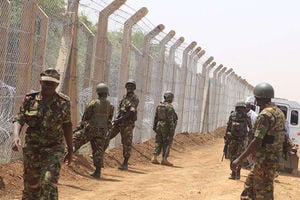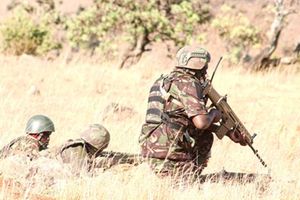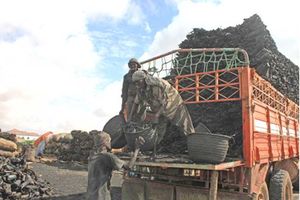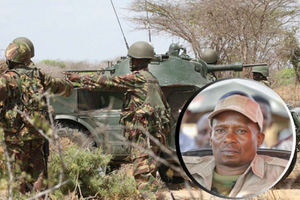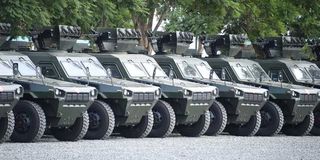
Armoured personnel carriers that were commissioned for the Kenya Police Service.
Kenya appears to be on a weapons buying spree, as the country goes for more sophisticated, modernised equipment to fight crime.
This was part of what Interior Cabinet Secretary Kithure Kindiki commissioned last week, Sh7.6 billion worth of state-of-the-art police equipment.
President William Ruto has vowed that modernisation of security equipment was just getting started, with a meeting of top security officials with the Head of State last week, resolving that Kenya will provide additional air support to back security men, with the Interior Ministry asked to expedite its police equipment modernisation plan.
The government has already announced that a projected allocation of Sh29.4 billion over the next three years would be used to fully upgrade police kits under the Police Equipment Modernisation (PEM) programme.
It aims to equip the police force with advanced protective gear and mobility equipment, including Armoured Personnel Carriers (APCs), Mine Resistant Ambush Protected Vehicles (MRAPs), Unmanned Aerial Vehicles (UAVs), drones, gunship helicopters, mine sweepers, and personal protection equipment.
The focus is on equipping and kitting frontline officers, especially those deployed in Forward Operating Bases (FOBs) across various regions which have for the past years been restive, owing to insecurity fueled by terror attacks, banditry and livestock rustling.
“I am honoured this afternoon to commission and dispatch the first batch of equipment to support Operation Maliza Uhalifu in North Rift Valley which will be extended to cover The Northern Grazing Area of Meru County, Isiolo and Marsabit Counties and counter-terrorism efforts in North Eastern Region and the Boni Enclave in Lamu County,” CS Kindiki said.
Police officers in these frontline areas were then ordered to act “mercilessly and thwart bandits and make sure they take down bandits and other dangerous criminals” and told that the government will stand behind any officer who uses the weapons under their control to neutralise threats posed by dangerous organised criminals.

Interior Cabinet Secretary Kithure Kindiki (center) with Interior PS Raymond Omollo, and Inspector General of Police Japhet Koome during an event March 12, 2024.
“I am announcing to these criminals that their days are numbered. We will fight them on land and from the air. We will strike them, we will pursue them in the deserts of Kenya, on sand, in the forest, valleys, gorges and caves, we have to terminate this rubbish,” the CS said.
CS Kindiki also cautioned politicians against meddling in the affairs of the State with regard to the fight against insecurity and said the government will do everything necessary to protect Kenyans.
Interior Principal Secretary Dr Raymond Omollo said the plan for modernisation of police service will go beyond the improvement of weapons to include effecting plans of improving police officers’ welfare.
This was followed by the Inspector General of Police’s stern warning to bandits “you are not going to scare us, intimidate us. By end of today, these equipment will be in these difficult places and we are going to deal with you ruthlessly,” he said.
This commissioning came months after Defence Cabinet Secretary, Aden Duale said the government was modernising the KDF and police artillery in June 2023 in what he termed a renewed effort to curtail operations by the Al-Shaabab militant group.
The CS said the equipment would include APCs with the ability to detect Improvised Explosive Devices often used by al-Shaabab along the areas under their command. Just two weeks before this pronouncement, at least 22 officers had been killed in attacks by the al-Shabaab in Garissa and Lamu counties.
Mr Omolo, who accompanied the CS, reiterated that officials who do not stay in their duty areas must resign. Over the years, Kenya has acquired a plethora of armoured vehicles, and other equipment for the security forces.
In 2019, Kenya signed a deal worth Sh9.87 billion to get 118 new armoured military vehicles for the country from Turkish manufacturer Katmerciler. This was the largest single order for such units in several years. The firm made the announcement in a regulatory filing with the Turkish stock exchange, the Borsa Istanbul.
Three companies had applied for the contract to supply vehicles to Kenya, including those from South Africa and North America but only Katmerciler met the user specifications. Deliveries of the vehicles was planned to begin in 2021 and be completed last year.
The Turkish manufacturer said the new vehicles can be used for combat, command and control, chemical, biological, radiological and nuclear defence, weapon carrier, ambulance, border security, and reconnaissance. The firm also added that the vehicles can withstand landmines and IEDs.
Between 2010 and 2019, the Kenyan Army operated an array of armoured vehicles conmprising Puma M26-15, WMZ 551BSI, Mamba MK5, Bastion and CS/VP 14. The newly acquired equipment were therefore a huge boost with the KDF saying the Hizir vehicles would be used for counterterror operations against the al-Shabab militant group.
In 2016, former President Uhuru Kenyatta commissioned 30 APCss for the police at the GSU Training School in Nairobi and said the vehicles were for protection to officers who were facing attacks by al Shabaab in areas along the country’s border with Somalia.
He was said the equipment would greatly support the police who for the first time had acquired armored personnel carriers to increase their mobility and protective gear when deployed in volatile zones.
“You don’t have to depend on the military or other security agents for you to perform your duties, we will ensure you are properly equipped. My government is ready to give you any resources to fight terror,” Mr Kenyatta said then.
In 2015, Kenya expanded its APC stockpile with the purchase of 30 carriers from China at Sh7.9 billion, which were deployed for police border patrols.
Whereas billions of shillings have been spent in the purchase of these vehicles, police officers and soldiers continue to be killed during IED attacks bringing to fore questions regarding the quality of the acquired vehicles.
Mr Dominic Pkalya, team lead for Peace Building and Conflict Transformation at Act Change Transform (ACT), believes something is wrong with the quality of APCs since they cannot “do what they should do”.
“Police and KDF while patrolling, using main roads, have been provided with APCs but could it be they are of inferior quality because why would they be blown out by IEDs? If we can budget billions for trivial issues such as tea in office governments, then we can surely buy good APCs,” said Mr Pkalya.
In December 2022, one Kenya Defence Forces soldier was killed in Lamu county, and four others were injured when their vehicle triggered an IED suspected to have been planted by the militants.
In June 2019, at least 12 Kenyan police officers were killed while another escaped with serious injuries after a vehicle they were traveling in was hit by improvised explosive device in Wajir county along the border with Somalia.
In the November 2017, CTC sentinel, Daisy Muibu and Benjamin Nickels’ article titled Foreign Technology or Local Expertise? Al-Shabaab’s IED Capability indicated that al-Shabaab most commonly use military explosives as its IED payload, notably cyclotrimethylene variants such as military-grade RDX.25.
In the event they do not have the military sources for main charges are unavailable, al-Shabaab substitutes them with TNT harvested from highly explosive artillery shells or anti-tank mines26 or with fertiliser which is widely available in Somalia.
“The key evolution is that al-Shabaab has become more adept in its deployment of bombs, tailoring its IED attacks through refined tactics, techniques, and procedures. In ambushes of security convoys and patrols along main supply routes, al-Shabaab strategically positions the IED to stop vehicles in a pre-determined ‘kill zone’ exposed to small-arms fire and rocket-propelled grenades,” the article stated.
To reduce future IED attacks, Kenya also has to be careful in the manner of weapons it uses with the study stating that other than the unexploded ordnances that litter the Somalia after more than a quarter century of conflict, al-Shabaab gets IED main charges from its enemies in Somalia.
“About 60 percent of the explosives contained in al-Shabaab attacks come from counterterrorism forces, obtained either from sub-munitions dropped by Kenyan warplanes,” the report stated.


